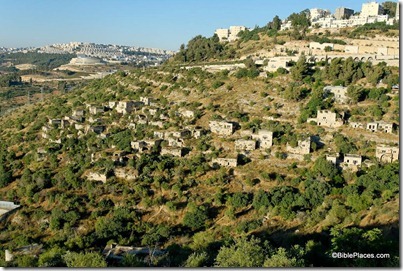On the outskirts of modern Jerusalem lies an abandoned Arab village that is likely to be identified with the biblical waters of Nephtoah. The site is listed on the Judah-Benjamin border in the tribal lists of Joshua (cf. Josh 18:15).
Joshua 15:8–9 (NIV) Then it ran up the Valley of Ben Hinnom along the southern slope of the Jebusite city (that is, Jerusalem). From there it climbed to the top of the hill west of the Hinnom Valley at the northern end of the Valley of Rephaim. From the hilltop the boundary headed toward the spring of the waters of Nephtoah, came out at the towns of Mount Ephron and went down toward Baalah (that is, Kiriath Jearim).
As Anson Rainey notes in The Sacred Bridge (p. 181), the name of the Arab village Lifta preserves the ancient name of Nephtoah. Gabriel Barkay has suggested that Mei (waters of) Nephtoah preserves the name of the Egyptian pharaoh Merneptah (“What’s an Egyptian Temple Doing in Jerusalem?” Biblical Archaeology Review 26/03, May/Jun 2000; online here).
The site is in the news today because of controversial plans to transform the crumbling village into luxury apartments and a hotel. From the Jerusalem Post:
In January, the Israel Lands Authority published a tender to build 212 luxury apartment villas and a hotel in the area of Lifta, turning the crumbling stone houses into lavish residences.
A coalition of activists successfully petitioned the Jerusalem District Court to halt the tender in March. The petition, filed by former Lifta residents, Rabbis for Human Rights, and Jafra, a Palestinian heritage organization, calls for the courts to freeze the bidding process and for the ILA to require that an independent monitoring organization complete a survey of the area to determine what should be preserved and what can be developed.
[…]
But the current legal impasse seems miles away from the peacefulness of Lifta, which has stood abandoned but largely intact for 64 years. It is the only completely abandoned Arab village that was not destroyed or inhabited by Jews after 1948, though its empty buildings have provided a haven for drug dealers, prostitutes and the homeless.
[…]
Isaac Shweky, the director of the council, takes a pragmatic approach to Lifta’s development: The site is in desperate need of repair, and if nothing is done it will continue to crumble away and eventually be reduced to nothing, as the weeds and vandals reclaim all 54 of the remaining structures. The cost to preserve the buildings would be astronomical, in the hundreds of millions of shekels. The only way to fund the preservation of the buildings, he believes, is to develop the site commercially.
The story includes a video interview with a former resident of the town who desires that the ruins be preserved as a witness to al-Naqba (“the Catastrophe”) of the founding of Israel in 1948.
